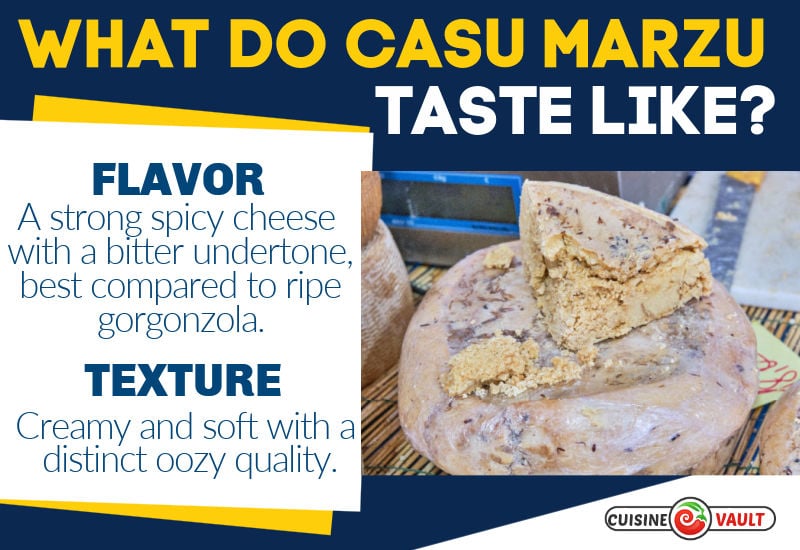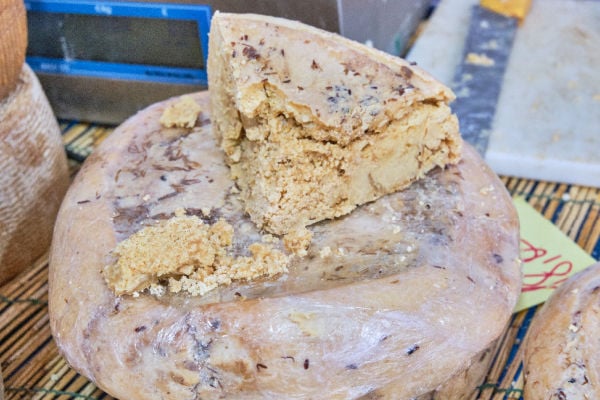Casu marzu is a Sardinian cheese that is produced using sheep’s milk and live maggots. It was banned by the European Union in 2002, making the sale of the product prohibited. However, it is still made by the locals for personal consumption and is considered a delicacy. So what does casu marzu taste like? Is it worth taste testing this bizarre-sounding food next time you’re in Italy? Is it even safe to eat? Let’s find out.
How does Casu Marzu taste?
Casu marzu is a strong spicy cheese with a bitter undertone that lingers in the mouth. Although its flavor is unique, people compare it to ripe gorgonzola, only a more intense version. Its texture is remarkably creamy and soft with a distinct oozy quality. A good wheel of casu marzu will produce a “tear” once sliced open – the amateur cheesemakers of Sardinia consider this a testament to a job well done.
 Interesting reading:
Interesting reading:
Want to make your own cheese at home? Not casu marzu, but delicious cheddar! Get started with a few simple pieces of equipment.
How is it made?
The cheese-making process takes a couple of months from start to finish, here are the steps.
- Pecorino cheese is made from sheep’s milk using the traditional method of production. This stage generally takes three weeks.
- The protective crust of the wheels is cut off or holes are cut into it to reveal the delicious interior of the cheese. This temptation is too much for flies and they begin to lay their eggs on the food.
- The cheese is stored in a dark place for up to three months or until the larvae hatch. Olive oil is added to soften the cheese and make it easier to penetrate. These tiny maggots begin eating the cheese which is now rotting as the rind is no longer intact. The larvae excrete the cheese back onto the block, giving it a distinct taste and consistency.
How is it eaten?
Casu marzu is traditionally eaten with the maggots still alive in the block, a sign that the cheese is in good health. Sardinians will provide some useful advice which is to always chew the cheese well. This ensures each maggot is chewed up and, without any doubt, dead before swallowing. Casu marzu is usually eaten with flatbread and red wine.
Is Casu marzu safe to eat?
The European Union deemed Casu marzu unfit for human consumption due to the obvious health risks associated with eating maggots. They can infest the inside of a human body, living off human tissue (myiasis) Source. The cheese is sometimes refrigerated to kill off the larvae, however, there are still risks associated with a bacterial infection.
 Fast facts about casu marzu
Fast facts about casu marzu
- For generations, the Sardinians have been making the cheese and it is commonly eaten at celebrations and weddings.
- The Italian government banned the cheese in 1962, which eventually led to an entire ban throughout the European Union in 2002. Its sale is now banned, although locals are lobbying to change this.
- Casu marzu was awarded the world’s most dangerous cheese in 2009 by the Guinness World Records.
Related reading:
Need a cheese substitute? We got the best alternatives for manchego, taleggio, fontina, and cotija.
Final words
Casu marzu is an Italian cheese that has gained a reputation for being a delicacy that comes with some health risks. Of course, the locals have been eating it for many years and they’ll tell you how safe it is. We recommend you do your research on whether it’s okay to eat before taking the plunge.
Perhaps the biggest challenge will be finding the cheese so that you can give it a taste test. As it can’t be sold commercially, you’ll need to know someone who makes it and is willing to share it with you. There is also believed to be a black market for this cheese, although we couldn’t confirm that.
The creamy, Gorgonzola-like cheese is one of the more unique foods found in Europe. We can see the appeal for any cheese-lover who wants to tick every cheese off their list. If you’re on the hunt for lesser-known foods, you may want to try something a little more mainstream, like brains or haggis? They’re tasty and not quite so illegal.
What is the best cheese you have ever eaten? Please let us know in the comments below.

Leave a Reply